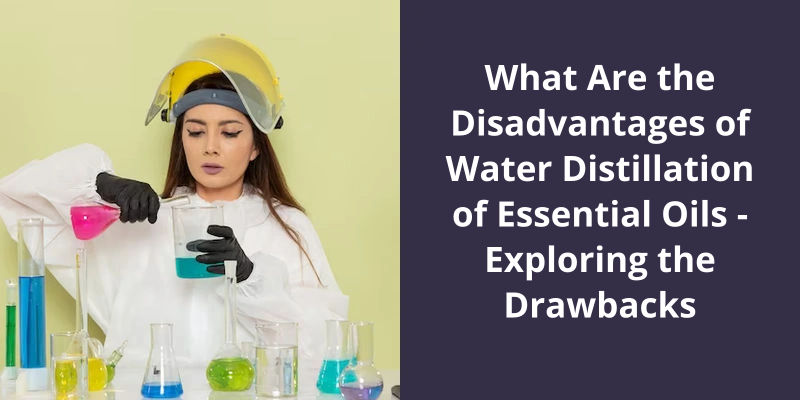The disadvantages of water distillation of essential oils are primarily related to the heat exposure and length of the process. Legitimate concerns exist that the high heat, usually over 100 degrees Celsius, can alter or degrade the aromatic compounds in the essential oils, diminishing their therapeutic properties. Additionally, water distillation is a significantly long process, lasting for several hours, which also contributes to the potential damage of the essential oils. Moreover, there are some oils that are not suitable for water distillation due to their specific properties, such as citrus oils. Lastly, the method could be less effective because essential oils being non-polar don’t mix with water and might float on the surface or get attached to the equipment, yielding less quantity of the oil obtained. Consequently, despite being a popular and traditional essential oil extraction method, water distillation has some limitations that can negatively affect the quality and quantity of the resulting oil.

What Are the Disadvantages of Steam Distillation?
Moreover, steam distillation requires a lot of energy to produce steam which increases the overall cost of production. This can be quite problematic for small scale industry owners who’re unable to afford expensive equipment required for steam distillation.
Another major disadvantage of steam distillation is that it may damage the delicate aromatic compounds of the essential oils being produced. This can be caused by prolonged exposure to high temperatures or even contact with hot water. As a result, the final product may have less aroma or even an altered fragrance than the original source plant.
This is because the process involves several steps such as heating, cooling, and separating the essential oils from the by-products. Careful monitoring of these steps is critical to prevent damage to the essential oils, which can reduce the quality and fragrance of the final product.
From reduced yield to increased processing time, damage to delicate aromatic compounds, high energy and water requirements, limited applicability and dependency on operator skills, these factors can impact the quality and quantity of the final product obtained.
Comparison of Steam Distillation With Other Extraction Methods, Such as Solvent Extraction or Cold Pressing
- Steam distillation
- Solvent extraction
- Cold pressing
When it comes to essential oil extraction, the method used can greatly affect the final product’s properties and benefits. Two common methods are steam distillation and hydro distillation. Studies have shown that oils produced through steam distillation have higher antimicrobial and antioxidant activities compared to those produced through hydrodistillation. However, hydrodistillation may be a better option for those seeking higher yields. Let’s take a closer look at the differences between these two methods and their respective advantages.
Is Steam Distillation Better Than Hydro Distillation?
Steam distillation and hydro distillation are the two most common methods used in essential oil extraction. While both methods produce high-quality oils, there’s been a debate about which one is better. However, studies have shown that steam distillation has some advantages over hydro distillation when it comes to the quality of extracted oils.
This is because steam distillation is able to capture more of the essential oils volatile compounds, which are known to have these properties. These volatile compounds are usually lost during hydrodistillation, which leads to lower quality oils.
This is because the steam used in the process helps to release more of the aromatic compounds in the plant material.
On the other hand, hydrodistillation is known to produce higher yields than steam distillation. This is because in hydrodistillation, the plant material is often in direct contact with the water, which helps to break down the cell walls and release more of the oil. In steam distillation, the plant material is placed in a separate chamber above the boiling water, which means that not all of the oil is extracted.
Despite the difference in yield, it’s important to note that the quality of the oil is more important than the quantity. While hydro distillation may be more cost-effective in some cases, the lower quality of the oils may not be worth sacrificing for a higher yield.
While hydrodistillation may produce higher yields, the quality of the oils is often compromised. Ultimately, the choice between the two methods depends on the specific plant material being used and the desired properties of the extracted oil.
Effects of Different Plant Materials on the Choice of Distillation Method
- Herbs
- Fruits
- Flowers
- Roots
- Barks
- Seeds
While the process of distillation has it’s benefits, it also comes with it’s own set of drawbacks. Some of these include the high energy consumption required, slow output in certain types of distillation, and the higher operating costs associated with the process.
What Are the Disadvantages of Distillation Process?
Distillation is a widely used method of separating mixtures using their boiling points. However, despite it’s benefits, there are several disadvantages associated with this process. The first and perhaps the most significant disadvantage of distillation is the amount of energy required to carry out the process. It’s well known that distillation is energy intensive and requires a lot of resources to maintain optimal temperatures throughout the entire process. This can result in high operating costs, significantly reducing it’s economic feasibility.
Secondly, traditional distillation techniques can be quite slow, meaning it might take a long time to obtain the desired output.
Distillation can also incur higher capital costs due to the need for sophisticated equipment to achieve good efficiency and yield. This investment is often a limitation for small-scale industries and individuals who can’t afford the equipment involved in the process.
There are also some challenges associated with the quality of the output obtained through distillation. Depending on the nature of the process and the quality of the raw materials used, substances like tars, acids and other impurities that are harmful to human health can be carried over into the final product, making it unsafe for consumption.
Lastly, distillation isn’t suitable for all types of mixtures. The process isn’t effective in removing contaminants and impurities that may have a boiling point above and near the boiling point of the desired chemical. Furthermore, some organic compounds decompose at high temperatures, and the distillation process can cause damage to the aroma, taste and color of the final product.
Comparison of Distillation With Other Separation Methods, Such as Membrane Filtration or Extraction.
This article discusses the differences between distillation and other methods of separating substances, like membrane filtration or extraction.
Distilling water is a common practice that involves boiling water to produce steam, which is then cooled and collected as distilled water. There are numerous advantages and disadvantages associated with this process, making it essential to understand the pros and cons before opting for this method of water purification. Here, we will discuss the various advantages and disadvantages of distilling water, ranging from pure drinking water and water distribution to the depletion of minerals and the creation of free radicals.
What Are the Advantages and Disadvantages of Distilling Water?
Distilling water is a process that involves boiling contaminated water and then condensing the steam back into water to create a pure, clean product. The main advantage of distilling water is that it removes impurities that may be present in the source water, such as chemicals, minerals, and bacteria, providing a pure drinking water that’s free from contaminants. This is especially important for people who’re sensitive to these contaminants, such as those with compromised immune systems or allergies.
While the process of distillation removes impurities, it also removes minerals, such as calcium, magnesium, and potassium, that are naturally present in water and are essential for good health. This means that drinking distilled water can lead to mineral deficiencies, which can have a negative impact on overall health over time.
This occurs because the high heat used in the distillation process can cause the water molecules to break down and create unstable molecular compounds that can cause oxidative damage. This is why some experts recommend adding minerals or antioxidants back into distilled water to counteract this effect.
For example, it allows for greater water distribution, as it can be produced anywhere, even in areas where the water is contaminated or scarce. This means that it can be used to help provide clean drinking water to communities that might otherwise be without it, improving public health and reducing the spread of water-borne diseases.
Ultimately, the choice of whether or not to drink distilled water will depend on personal preference and individual health concerns, and should be made after careful consideration of all the available information.
However, there are other distillation methods that are used to extract essential oils, each with it’s own unique set of advantages and disadvantages. Let’s take a closer look at some of these methods and find out which one is considered the best distillation method for essential oils.
What Is the Best Distillation Method for Essential Oils?
These compounds then rise with the steam and are collected in a cooling chamber, where they’re condensed back into a liquid state. The resulting liquid, known as a hydrosol, contains both the essential oil and water-soluble components of the plant. Separation of these two components is achieved through a process known as decantation.
Another popular distillation method is known as water distillation, in which plant materials are boiled in water rather than steam. This method is best suited for use with plant materials that aren’t easily vaporized by steam, such as roots, barks, and woody materials. The resulting hydrosol is usually less fragrant than those produced by steam distillation, but it can still be used in a variety of applications.
A less commonly used method of essential oil extraction is known as cold pressing. This method involves the physical crushing and pressing of plant materials to release their volatile compounds. Cold pressing is best suited for citrus fruits, as they contain large amounts of oil in their peels. The resulting oil is highly fragrant and can be used in a variety of applications, including perfumes, aromatherapy, and cleaning products.
Another innovative method of essential oil extraction that’s gained popularity in recent years is known as CO2 extraction. This method involves the use of pressurized carbon dioxide to extract the essential oils from plant materials.
Overall, the best distillation method for essential oils will depend on several factors, including the specific plant materials being used and the desired end result. While steam distillation is the most commonly used method and is suitable for use with a wide range of plant materials, other methods such as water distillation, cold pressing, and CO2 extraction may be more appropriate in certain circumstances.
The History and Evolution of Essential Oil Distillation Methods
Essential oil distillation methods have been around for thousands of years and have evolved over time. They began with simple methods like pressing, squeezing, and soaking botanicals in oils or water. The use of alchemy and chemistry in the Middle Ages further developed the distillation methods in Europe. With the advancements in technology, steam distillation became the most commonly used method in the 19th century. Today, various types of distillation methods are used, including steam, water, and cold pressing, each having it’s own benefits and drawbacks.
Conclusion
In conclusion, although hydrodistillation is a conventional method used for the extraction of essential oils, it still has some disadvantages. One of the major issues is the contamination of extracts with solvent or solvent residues, which can affect the quality of the final product. Additionally, thermal decomposition of extracts can occur during the process, leading to the loss of valuable compounds. Moreover, the pollution of residual vegetal material with solvent can also be an environmental problem.





